How to Build a Target Audience Profile in 4 Easy Steps

Conteúdos
Truly understanding your audience is fundamental for affiliate marketers who want to connect effectively and drive conversions. But pinpointing who your audience is can often feel like solving a complex puzzle.
You might find yourself grappling with questions like:
- Who are they?
- What do they want?
- Where do they spend their time online?
- And crucially, how can you forge meaningful connections with them?
Answering these questions is vital, as your target audience is out there: actively looking for solutions –solutions your affiliate products or services are uniquely positioned to provide.
But where do you start? The first step is creating a detailed target audience profile. This invaluable report allows you to delve deep into understanding who your potential customers are, what they value, and how your offerings can significantly impact their lives.
In this article, we'll define what a target audience profile is, explore why it’s crucial for your success, and discuss how it can transform your approach to affiliate marketing. Additionally, we’ll walk you through the process of building this profile in just 4 easy steps.
What is a Target Audience Profile?
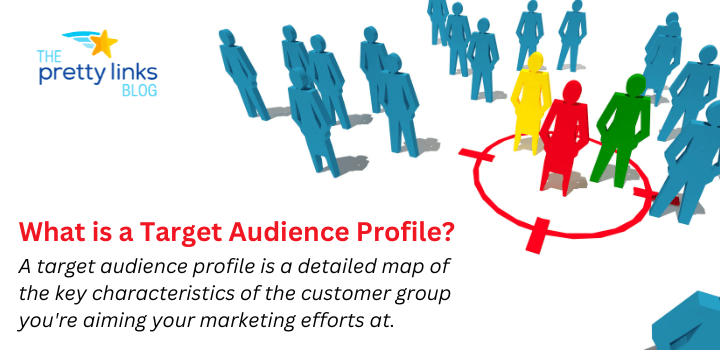
A target audience profile is basically a detailed map of the key characteristics of the customer group you're aiming your marketing efforts at.
Depending on your business goals, your niche, the products you market, and the customers you want to attract, you might end up creating several different personas.
These personas help pinpoint various segments you want to target, making it easier to keep your marketing strategies focused and your messaging consistent. When what you offer lines up with what your audience needs, you’re more likely to see an uptick in conversions.
Target Audience Profile vs. Target Market: What's the Difference?
A target audience profile details the essential traits of an ideal customer you're targeting with your marketing or advertising efforts. This profile acts as an avatar, designed to steer your campaigns toward greater engagement and effectiveness.
This concept is more specific compared to broader terms like a target market or buyer persona, which refer to a larger group of potential customers.
For instance, in the tech products niche, your target market could be segmented into:
- Tech enthusiasts who always want the latest gadgets,
- Practical tech users looking for durable and cost-effective devices,
- Eco-conscious consumers seeking sustainable tech solutions,
- Corporate buyers interested in bulk purchases for operational needs.
Each of these shopper types has unique preferences, motivations, and purchasing behaviors, which requires distinct marketing approaches and product offerings.
In contrast, a target audience profile would drill down into the specifics of one such shopper, providing a focused lens through which to view your marketing strategies and product alignments.
What Details Should You Include in a Target Audience Profile?
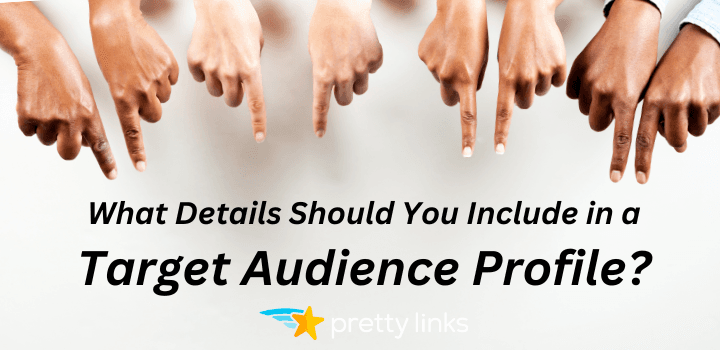
Creating a target audience profile involves compiling crucial information about potential customers:
Demographics: Start with the basics, such as discovering where they live, their age, educational background, occupation, and income level. These factors can greatly influence buying choices and preferences.
Psychographics (Objectives, Pain Points, and Hurdles): Get to know their personality traits, interests, goals, values, and life choices. What are they trying to achieve? What obstacles could your product or service help them overcome? Think about the questions they might be asking on search engines that lead them to solutions like yours.
Buying Behavior: Are they impulsive buyers or do they consider their purchases carefully? Do they shop throughout the year or are there specific times when they're more likely to buy? Understanding this helps tailor your sales tactics.
Go-to Platforms: Identify where they spend most of their online time. Are they active on social media platforms like YouTube or Instagram, or do they begin their product searches on Google?
Content Preferences: Once they've found you, what type of content resonates with them? Whether it's ebooks, blogs, case studies, podcasts, or videos, knowing what they prefer ensures that your message hits home in the right format.
By piecing together these details, you can craft a profile that not only describes who your audience is but also guides how to best connect with them.
How to Build a Target Audience Profile in 4 Easy Steps
Chances are, you've got a rough sketch of your ideal customers in mind. Maybe you've even dipped into customer feedback, testimonials, or other kinds of social proof to shape your marketing strategies.
This is a great start, but delving deeper to create a comprehensive target audience profile can really refine your understanding of what your customers desire and how you can meet those needs.
Fortunately, building this profile doesn't have to be overwhelming. It’s about dedicating some time to research and digging into the details.
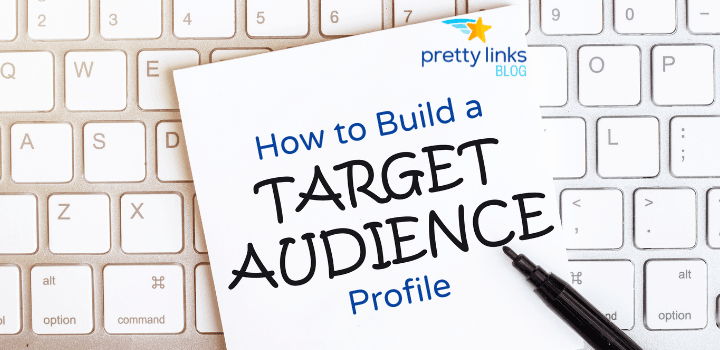
Step 1: Outline Your Ideal Customer Profiles
Begin with a broad view of what attracts customers to your brand and the value you provide. Use customer feedback and metrics you’ve collected to kickstart this process. Consider how your customers view your offerings.
- What aspects resonate with them?
- How does your product or service make their lives easier?
Imagine you run a blog about home improvement tools. You might have a reader like Jamie, a DIY enthusiast who looks for efficient tools to help with home projects.
A website offering a wide range of DIY kits, tool reviews, design inspiration, and step-by-step guides would appeal to her. Ensuring the site is user-friendly and offers content for various skill levels would make it even more attractive.
Step 2: Focus on the Details with Demographics, Lifestyle, and Mindset
Next, you want to refine your audience profile with more specific details:
- Demographics: Fill out basic demographic information including age, location, occupation, income, marital status, and preferred social platforms. This provides a foundation for understanding your audience.
- Lifestyle Choices: Examine the daily choices and habits that define your potential customers. What does a typical day look like for them? Which brands do they rely on? How do they research products before purchasing? Understanding these elements helps you align your brand with their everyday lives.
- Mindset and Motivations: Dive into the psychographics of your audience. Are they introverts or extroverts? Do they make decisions based on emotion or logic? What values are important to them? Understanding these motivations reveals the core of your customers’ personalities and guides how you communicate with them.
By exploring these layers, you'll build a comprehensive profile that helps tailor your marketing efforts more precisely, ensuring your messages hit the right note every time.
Step 3: Pin Down Their Pain Points and What Your Audience Really Needs
At this stage, you should be getting a clear picture of your “ideal” customers. Now you want to focus on what they need to overcome the problems they face.
From your customers’ perspective, consider:
- Why would they choose your product or service recommendation?
- What solutions does it offer for their specific challenges?
- Are there any barriers that might prevent them from choosing your product?
Addressing these questions helps you refine your marketing pitch to make your product irresistible.
Step 4: Figure Out How Your Audience Will Find You
Finally, it’s vital to understand how potential customers will discover your business. Consider the paths your audience might take to bump into your brand. This involves understanding their online hangouts and habits, including:
- The types of websites they frequent
- Their go-to blogs for information or entertainment
- Their preferred social media platforms
- The keywords or phrases they might use in searches
- The kind of content that captures their interest
For instance, if your offerings include eco-friendly home goods, platforms like Pinterest or Instagram could be pivotal in your marketing strategy, showcasing the aesthetic and sustainable aspects of your products.
Conversely, if you're in the business of gadgets, gizmos, or software, engaging with communities on Reddit or tech-focused blogs might be the way to go, tapping into the tech-literate and geeky audience looking for the latest innovations.
The key here is to meet your audience where they're most at ease and engaged, boosting your chances of connecting with the right crowd and making a lasting impression.
Putting Your Target Audience Profile to Work
Once you’ve crafted a robust target audience profile, the next step is to put it into action across your marketing initiatives.
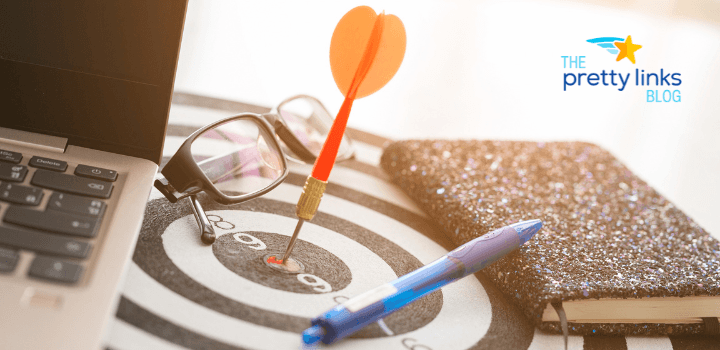
Use this profile as a blueprint to guide your marketing strategies. It should influence where to focus your efforts on social media, what type of content to create for your website, and even the tone and style of your communications.
Understanding where your audience spends their time and what they care about helps you choose the right platforms for engagement.
Additionally, your target audience profile reveals how your audience prefers to communicate. This insight allows you to adjust your messaging to ensure it resonates deeply and effectively.
For instance, if your audience favors detailed, informative content, you might focus on developing comprehensive guides or in-depth blog posts.
Moreover, knowing your audience’s preferences and behaviors can spark creative marketing ideas.

Perhaps they engage more with video content than text, or maybe they’re active participants in specific online communities. Tailoring your approach to fit these preferences not only enhances engagement but also boosts the likelihood of your campaigns' success.
Ultimately, your target audience profile isn’t just a tool for identifying your audience – it’s essential for shaping how you interact with them, making your marketing efforts more targeted and impactful.
Next Steps: Deepening Your Audience Insights
Eager to dig even deeper with what you've uncovered? Consider breaking down your audience into more detailed groups.
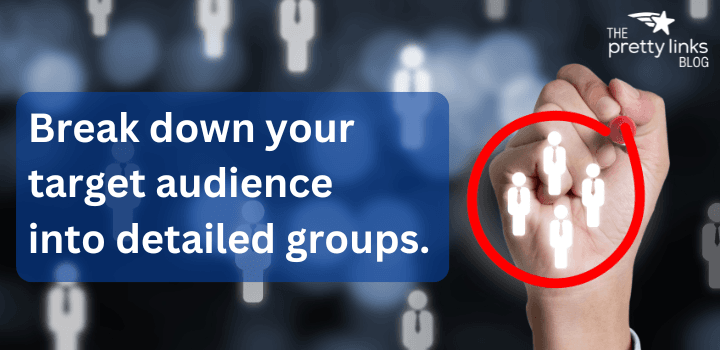
This process often reveals several distinct personas within your broader audience, each with unique needs and preferences.
Take the example of a meal planning website. As you analyze your user base, you might identify distinct segments like busy professionals in need of quick, healthy meal options, fitness enthusiasts searching for diet-specific recipes, and families looking for diverse, kid-friendly meals.
Tailoring your content and features to meet the specific requirements of these groups can significantly enhance user satisfaction and engagement.
To effectively manage and communicate with these segments, you can utilize marketing tools that allow for detailed audience segmentation. Platforms like ConstantContact and HubSpot are invaluable here; they not only help you segment your audience but also provide insights that can refine your marketing strategies further.
These tools enable personalized communication, ensuring that each segment receives content that is most relevant and engaging to them.

By adopting such targeted approaches, you can make your marketing efforts more precise and effective, leading to higher engagement and better conversion rates.
Conclusion
Understanding and defining your target audience is fundamental for ensuring your marketing efforts are successful. A well-crafted target audience profile enables you to create content that resonates deeply with your potential customers.
Here's a quick recap of the steps:
- Begin with a general description of your ideal customer base.
- Explore their demographics, lifestyle choices, and mindset to gain deeper insights.
- Identify their core needs and the challenges they face.
- Determine how and where they are most likely to encounter your brand.
By following these steps and leveraging tools for audience segmentation, you can ensure your marketing efforts resonate more effectively with your intended audience, thereby enhancing engagement and conversion rates.
If you have any questions about developing or applying your target audience profile, don't hesitate to ask in the comments!
If you liked this article, be sure to follow us on Facebook, Twitter, Pinterest, and LinkedIn! And don't forget to subscribe in the box below.